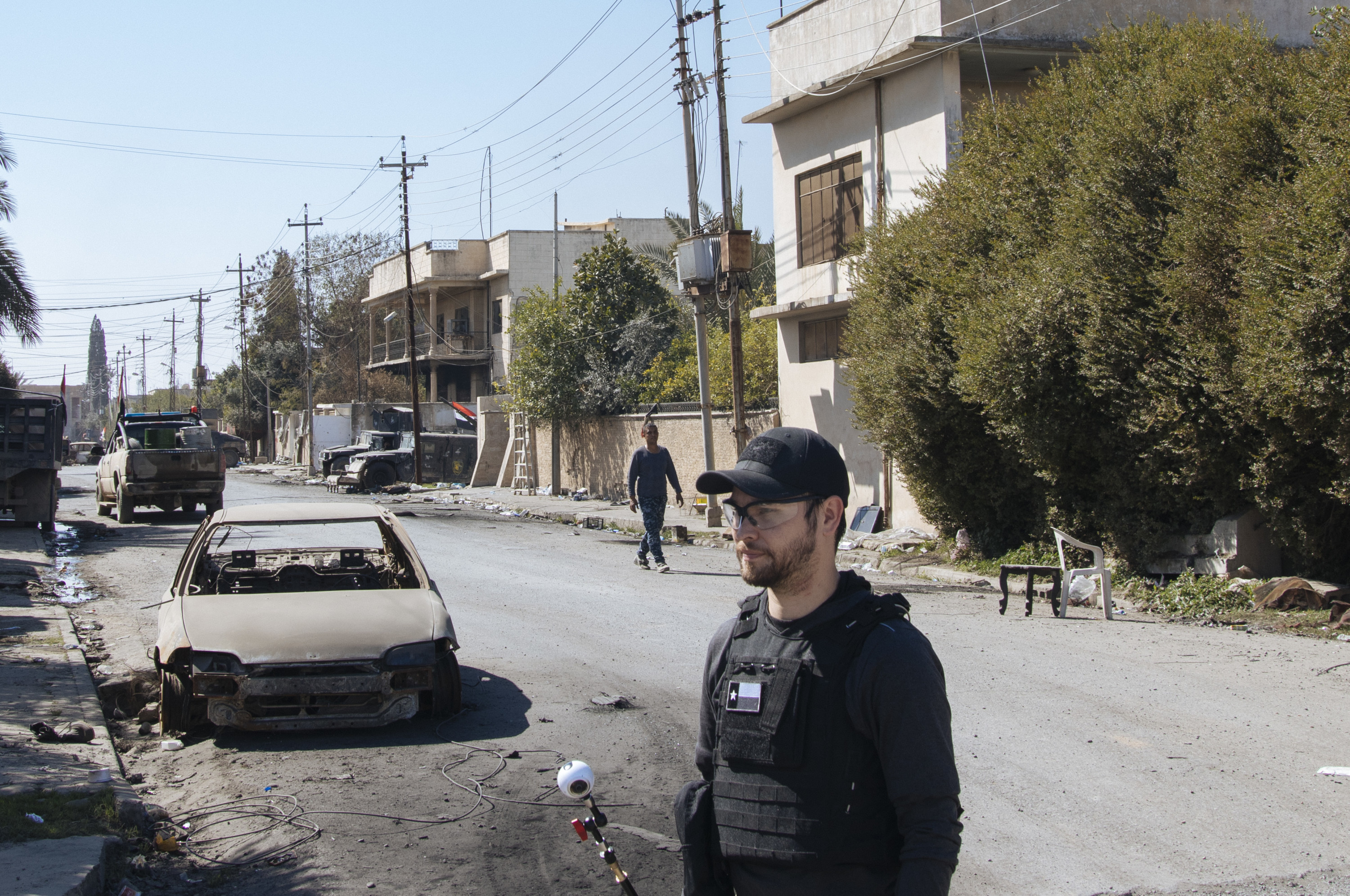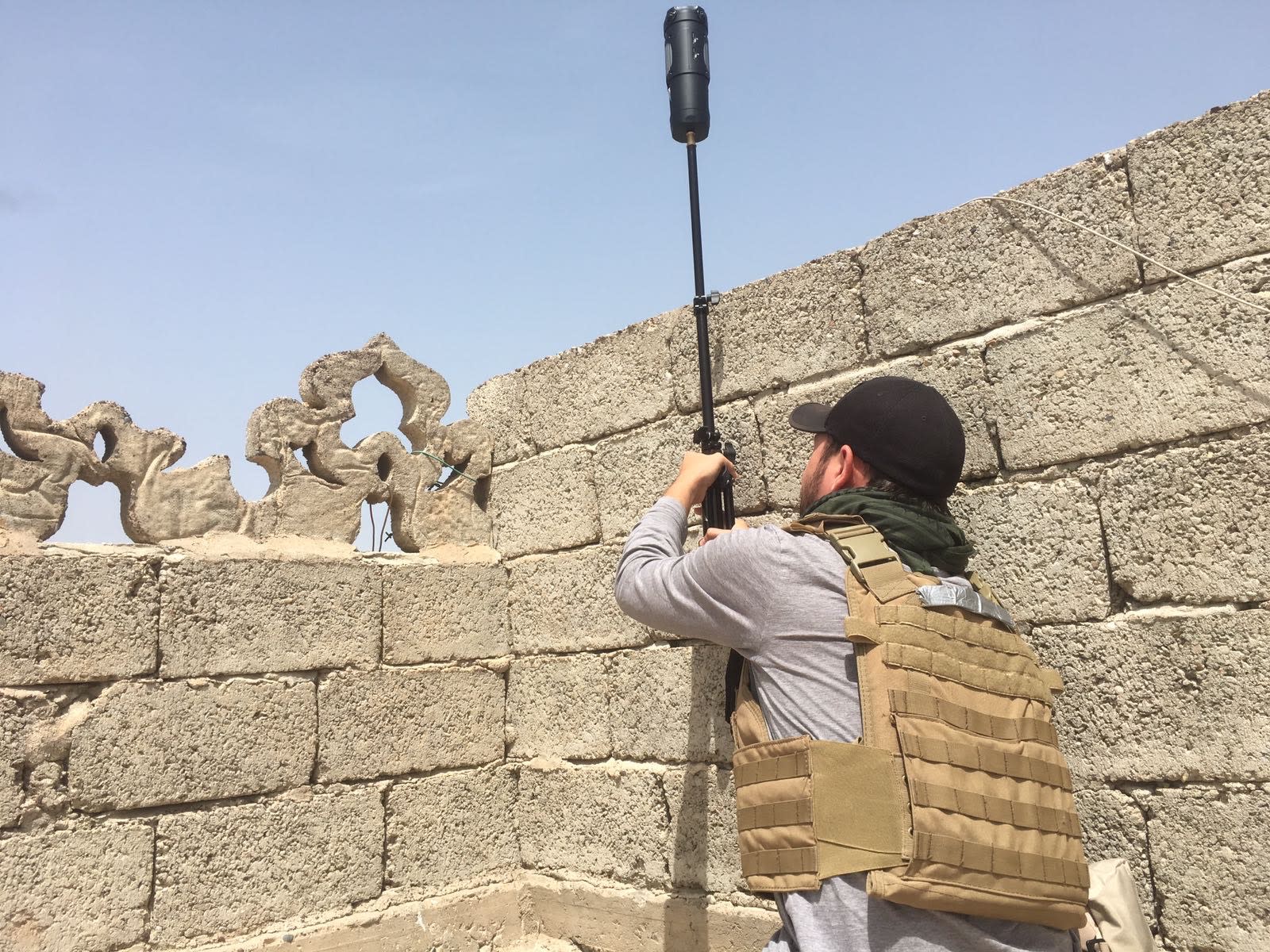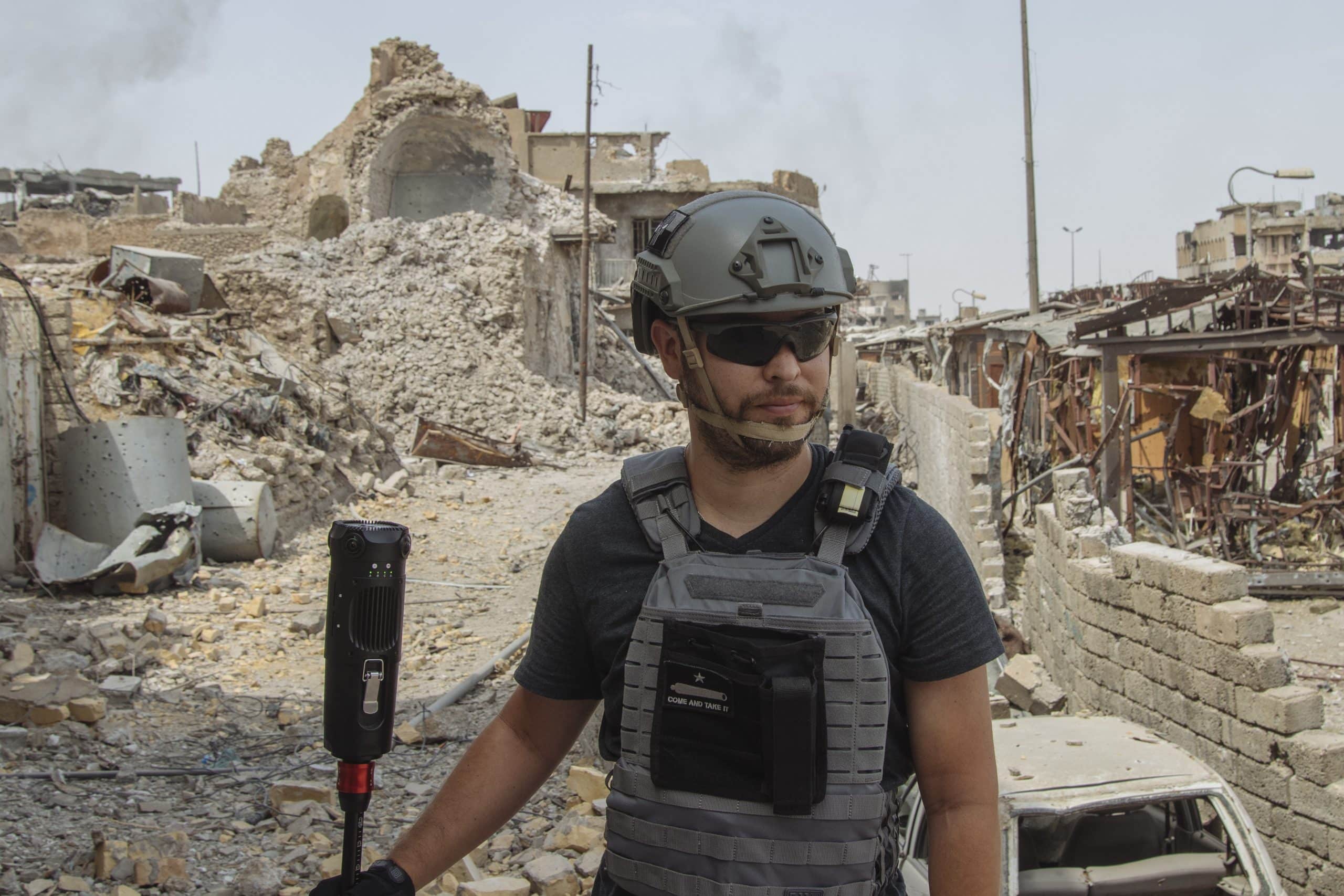Die Straße ist gespenstisch ruhig. Asche und Staub säumen die Bürgersteige, während die zertrümmerten Fassaden der Wohnhäuser auf längst verlassene Räume hinweisen. In der Ferne sind verstreute grau-grüne Bäume die einzigen Zeichen von Leben oder Farbe. Seit 6.000 v. Chr. leben Menschen in dieser Gegend. Jetzt schallt das Geräusch der nahen Schüsse durch die leeren Straßen.
Im Jahr 2015 hat die Multimedia-Produktionsfirma Freiberufliche Gesellschaft reisten nach Syrien, um die Verwüstungen des andauernden Bürgerkriegs zu dokumentieren. Dabei setzten sie sich erheblichen Risiken aus, um aus erster Hand über einen Konflikt zu berichten, über den kaum berichtet wird. "Wahrscheinlich ist es am unsichersten, 360°-Filme in einem Konfliktgebiet zu drehen", gibt Dylan Roberts zu, der als Freelance Society-Filmer aus Syrien berichtet hat. "Du musst die VR-Kamera alleine stehen lassen. Dann musst du irgendwie aus der Aufnahme herauskommen - was schwer ist, vor allem, wenn es nicht viel Platz gibt, um sich vor Kreuzfeuer zu verstecken."
Solche beruflichen Risiken gehören zum Job dazu. Als Mitbegründer und CEO von Freelance Society verdient Roberts seinen Lebensunterhalt, indem er für Kunden wie die "Freelance Society" zu den Epizentren von Naturkatastrophen und bewaffneten Konflikten fährt. Vize, Die New York Times, und Der Wirtschaftswissenschaftler. Allein in den letzten zwei Jahren berichtete er aus einem behelfsmäßigen Krankenhaus in einem verlassenen Haus im Irak, überquerte die ungarische Grenze an der Seite von Migranten, die vor ISIS und Boko Haram flohen, und deckte die Desorganisation der Hilfsmaßnahmen nach dem verheerenden Wirbelsturm 2016 in Haiti auf.
Vor kurzem war Roberts aus Oklahoma in Houston, um die Folgen des Hurrikans Harvey zu dokumentieren. Sein beeindruckendes Filmmaterial zeigt eine 360-Perspektive eines Improvisierter Kirchenunterstand und die Aussicht von einem Schnellboot aus entlang einer Vorstadtstraße. Roberts stammt aus Texas und seine alte Nachbarschaft stand immer noch unter Wasser, als ich ihn für unser Interview erreichte.
Bevor er sich auf seine nächste Reise in den Irak vorbereitet - er arbeitet seit über acht Jahren in dem Land - sprach Roberts mit Format über seinen beruflichen Werdegang, seinen Glauben an die Erzählkraft von VR und ihre potenziellen Auswirkungen auf große Nachrichtenredaktionen und Bürgerjournalisten.

Roberts' Weg zur Kriegsberichterstattung war ein direkter. Seine Eltern lernten sich im Heimatland seiner Mutter, Paraguay, kennen, als sein Vater mit dem Friedenskorps im Land stationiert war, und die Familie reiste während Roberts' Jugend viel herum. Als er 18 Jahre alt war, hatte er bereits als Journalist, Fotograf und Redakteur international gearbeitet. Als er sein Studium abschloss, umfasste sein langer Lebenslauf Reportagen in Äthiopien, Uganda, dem Irak und dem Libanon.
Über sein Netzwerk aus globalen Kontakten und lokalen Vermittlern hörte Roberts von Christian Stephen, einem gleichgesinnten britischen Journalisten und Highschool-Abbrecher, der mit 15 Jahren seine Heimat verlassen hatte, um den somalischen Bürgerkrieg zu dokumentieren. In Stephen fand Roberts einen Gleichgesinnten, der seine Leidenschaft für das Aufspüren unerzählter Geschichten an komplexen, unzugänglichen Orten teilte. Trotz des Ozeans zwischen ihnen arbeiteten die beiden schnell zusammen an dem 2013 erschienenen Der Vikar von Bagdadein abendfüllendes Profil eines anglikanischen Priesters, der in der roten Zone Bagdads unter der Bedrohung durch ISIS arbeitet. Ihr preisgekrönter Film wurde uraufgeführt, bevor Stephen 19 und Roberts 23 Jahre alt wurden.
Roberts und Stephen erkannten schon früh das immense Potenzial von VR/360 und begannen 2015, es in ihrer neu gegründeten Produktionsfirma Freelance Society einzusetzen. Immer bereit, sich kopfüber in eine Herausforderung zu stürzen, veröffentlichten sie das bahnbrechende Willkommen in Aleppo innerhalb weniger Monate nach ihren ersten Experimenten mit der Technologie. Als Nächstes schleppten die beiden ihre neuen Kameras und Rigs nach Nepal, um die anhaltenden Auswirkungen des Erdbebens von 2015 auf die Kinder des Landes zu dokumentieren - und enthüllten dabei, dass sie Menschenhandel, Frühehe und Kinderarbeit ausgesetzt sind. Schließlich konnten Roberts und Stephen die tieferen humanitären Auswirkungen hinter kurzen, überschaubaren Schlagzeilen in einem Format zeigen, das es den Zuschauern nicht erlaubt, wegzuschauen.
Der Markt für VR/360-Meldungen hat sich in den zwei kurzen Jahren seit Willkommen bei Aleppo's veröffentlichen. Verkaufsstellen wie Die New York Times, CNN, und The Guardian haben ihre eigenen 360°-Produktionsstudios eröffnet, während unzählige andere Inhalte bei Freiberuflern in Auftrag geben. Da schwindende Einnahmen und Budgetkürzungen Journalisten immer mehr an ihren Schreibtisch fesseln, können 360-Videos den Zuschauern eine einzigartige Perspektive bieten, die sie direkt in das Geschehen hineinversetzt.
In einer Zeit, in der die Medien immer genauer hinschauen, bieten VR-Aufnahmen auch den verlockenden Anschein von Objektivität. Es gibt keine Bedenken mehr, dass etwas nicht im Bild ist oder ein Bild aus dem Kontext gerissen wurde. "Bei traditionellen Methoden des Geschichtenerzählens können Journalisten die Atmosphäre manipulieren", sagt Roberts. "Aber mit VR ist das viel schwieriger. Sie zwingt dich dazu, authentisch zu sein."
VR hat einen rasanten Aufschwung erlebt, aber viele Medien tun sich noch schwer damit, das volle Potenzial dieser Technologie zu nutzen. Virtual-Reality-Videos entstehen, indem mehrere Kameras gleichzeitig Aufnahmen machen und die einzelnen Clips dann zu einem nahtlosen Bild zusammengefügt werden. "Im Moment ist VR/360 für eine qualitativ hochwertige Produktion noch sehr arbeitsintensiv", sagt Roberts. Für ein Publikum, das mit einem 24-Stunden-Nachrichtenzyklus aufgewachsen ist, kann die längere Vorlaufzeit von VR einen Dämpfer bedeuten, wenn die nächste große Geschichte ansteht.

Ein weiterer Punkt ist der Zugang zum Publikum. Die große Mehrheit der Verbraucherinnen und Verbraucher sieht sich Inhalte über ihre Telefone, Tablets und Computer an - nicht über spezielle Headsets. Der Effekt ist immer noch beeindruckend, aber es fehlt die wirklich immersive Qualität der VR-Erfahrung. Ebenso sind die meisten VR-Berichte eigentlich nur 360°-Videos, da die Bezeichnung "VR" auf eine gewisse Interaktivität mit den Objekten im Bild hinweist. Roberts ist jedoch optimistisch und sagt voraus, dass die jüngsten Sprünge in der VR/360-Technologie und ihre zunehmende Erschwinglichkeit bald zu einem entsprechenden Anstieg des Bürgerjournalismus führen werden.
So vielversprechend die VR-Technologie auch sein mag, sie ist nur ein Hilfsmittel und kein Ersatz für eine tolle Geschichte. Wann hast du dich das letzte Mal hingesetzt, um einen Film zu sehen? Avatar? "VR-Inhalte müssen einen Grund haben; es muss das beste Medium sein, um diese bestimmte Geschichte zu erzählen", sagt Roberts. "Normalerweise erzählen Christian und ich nur dann Geschichten in 360/VR, wenn die Geschichte schwer zugänglich ist, an einem Ort, an den die meisten Menschen nicht reisen können, um sie selbst zu sehen."
Egal, ob du von spielenden Kindern in einem irakischen Flüchtlingslager umkreist wirst oder die Gesichter von einwanderungsfeindlichen Demonstranten scannst, während ihr gemeinsam durch die Münchner Innenstadt marschiert, es ist eine zutiefst emotionale Erfahrung, am Ende dieses Zugangs zu stehen. Das Google News Lab hat dieses Gefühl in einem ethnografische Studie die in diesem Sommer veröffentlicht wurde, stellte fest, dass "die Eindrücke der Nutzer von einem Virtual-Reality-Erlebnis dem Gedächtnis ähneln, wobei die Momente einer VR-Geschichte wie gelebte Erfahrungen verarbeitet und konsumiert werden". In der Studie wird ausdrücklich empfohlen, dass sich Geschichtenerzähler/innen und Journalist/innen, die in der VR arbeiten, darauf konzentrieren sollten, "einen emotionalen Eindruck zu vermitteln, auch auf Kosten der Vermittlung von spezifischen Informationen".
Da VR-Filmmaterial unsere Emotionen auslöst und in unserem Gehirn eher als Erinnerung denn als Tatsache registriert wird, ist es ein hervorragendes Werkzeug für Lobby-Journalismus, NGO-Kommunikation oder ähnliche Bereiche, die ihre Informationen strategisch verpacken, um ihre Empfänger zu einer gewünschten Handlung zu bewegen. In einer aktuellen Verkabelt ProfilStephen merkte an, dass es bei seiner eigenen Berichterstattung "nicht nur darum geht, Empathie zu fördern, sondern auch darum, was aus der Empathie entsteht - was danach passiert".
In diesem Punkt weicht Roberts schließlich von seinem langjährigen Partner ab. "Für mich als Journalist ist es meine Aufgabe, die Geschichte so sachlich wie möglich zu erzählen, egal ob es sich um VR, Dokumentationen, Print oder Fotos handelt", sagt Roberts. "Ich versuche nicht, meine Meinung oder einen Aufruf zum Handeln in meine Arbeit einfließen zu lassen, sondern einfach zu informieren und Geschichten zu erzählen."













